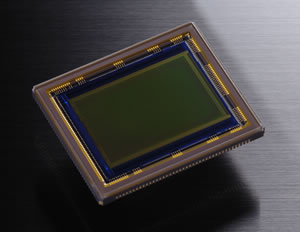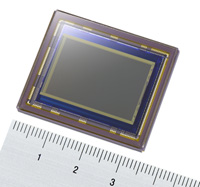Nikon D300 and Sony A700 sensor similarity
THE specifications of the CMOS 13.1 megapixel, 12.3 effective megapixel sensor used in the Sony Alpha 700 and the Nikon D300 continue to provoke discussion. On the one hand, we have Sony’s own announcement of the ‘commercialisation’ of the IMX21 sensor in August, preceding Nikon’s advance publicity by a few days. On the other hand, we have people who refuse to believe that Nikon, who openly bought Sony CMOS technology to create the D2X, is not entirely responsible for its own sensor.
Here is a picture of the Nikon sensor:

And here is a picture of the Sony IMX21:

The two are clearly the same item, bar any minor differences to the type of AA filter, glass cover coating, and modifications to circuitry. It is also possible that Nikon may have a rigid quality control floor below which sensors are rejected on the test bed. This has been a persistent rumour, that Sony ends up using the sensors which fall below Nikon’s stringent requirements. It seems unlikely that Sony would risk their reputation in this way.
In the Sony publicity, it was claimed that the IMX21 has 12-bit on-sensor A to D but can also feed an analog output to be used by an external A to D converter – it has twin output possibilities.
Nikon state in their own publicity that their sensor has on-board A to D conversion, stating 14-bit, but they do not elaborate as to whether they use the 12-bit onboard the same as Sony for their 8fps performance (the sensor can achieve over 10fps with a fast enough processor) and use the analog feed and their own 14-bit external converter – which only runs at 2.5fps. Or, they may have commissioned a modification to the onboard A to D which permits 14 bit. This seems unlikely when the provision was made for higher bit depth external conversion from the start.
Sony’s .ARW2 file format, uncompressed, is 12-bit. Their cRAW compressed format uses 8-bit depth. Nikon’s formats are 14-bit and 12-bit. There is clearly a substantial difference in the A to D for 14 bit but I would suggest that Nikon’s 12-bit output is using the same on-chip process as Sony’s 12-bit. Nikon makes no claims for on-sensor noise reduction but, again, it seems likely this is happening. It appears to be part of the sensor design.
Some out there may have more detailed information, but until we learn of some unique modifications made by Nikon to the actual silicon itself, we can assume that the bit where the photons hit the pixels is pretty much the same item.
– David Kilpatrick

Would like to hear more about the pepcok post. Interesting indeed. Maybe DK or someone else will chime in?
-Sonolta
http://www.sonolta.com
A norwegian journalist claiming he’s got an confirmation that the sensors are not similar “I asked a top Nikon representative Who manufactured the sensors, NIkon or Sony? The clear answer was “neither””
http://foto.no/cgi-bin/diskusjon/lesTraadHier.cgi?id=314359
Editor comments – They are clearly the same sensor, the Sony IMX21. No two differently made sensors have exactly concurrent mounting and pinouts, these two do, and photographs show. As stated, this does not prevent Nikon from using different signal paths to handle the image on and off sensor. The results are different.
David
David,
what about the DIWA tests indicating that the A700 sensor has a 1.5EV advantage in dynamic range compared to the D300 sensor? Please have a look at this : http://www.diwa-labs.com/wip4/test_result.epl
Reply from David: DIWA does not state whether their test used 12-bit or 14-bit conversion in the D300. 14-bit conversion can handle two stops more dynamic range than 12-bit, and there is definitely some loss if you choose 12-bit in the D300. The A700 is 12-bit only, but of course, the A to D circuit can compress by using a modified tone curve. There is also a real possibility that the entire Nikon ‘loss’ is placed at the low bit end (which would explain the exceptional noise levels). If you sacrifice more than the usual low bit data, you can lose a lot of noise along with two stops of DR. Sony clearly does not sacrifice anything if it is getting over 11 stops DR from a 12-bit raw image – that is within less than one stop of perfection! Normally, you can only get within two stops – 12-bit data will at the best yield a 10 stop DR. To be honest, the DIWA comparison surprises me, because in use the D300 appears to have just as much adjustment leeway and scope for handling under/over exposed files as the A700. Whatever the case, it’s not sensor which is making the difference, it is the signal path and processing. Both are IMX21 sensors, we know that for sure. What is tacked on to them is very different.
I believe “insignficant” can mean duplicate and/or repetitive as well as meaningless. Far different from JPG’s “insignificant”, IMHO.
In my personal experience I have concluded cRaw and Raw IQ are the same in the end.
Sony says this:
Are there any differences in picture quality between cRAW and RAW?
No, there is no differences. Quality is not a problem even when compressed, but for those users who like uncompressed data, we left the uncompressed raw data support.
http://support.sony-europe.com/DIME/faq/faq.asp?l=en&c=DIME&sc=DSR&m=DSLR-A700&f=mod_DSC_A700
I like to key on the words “no differences” 😉
-Sonolta
http://www.sonolta.com
Hi David,
It still isn’t actually that clear whether the compression is lossless or lossy.
I’m pretty sure ATRAC is lossy as is (generally) “bit depth compression”.
If you compress “insignificant information”, this to me implies that a lossy compression is being used rather than lossless.
I would guess that high quality Jpeg could be considered to also “compress only insignificant information”.
I found this comment interesting…
“Sony’s .ARW2 file format, uncompressed, is 12-bit. Their cRAW compressed format uses 8-bit depth.”
I thought that the cRAW was supposed to be identical to the RAW?
Can you confirm that the cRAW is actually only 8bit depth, which if I understand right, means that you have less dynamic range with cRAW.
DK replies – it is definitely 8-bit. Sony describe it as ‘lossless bit depth compression’. I do not understand that fully, but maybe it works like ATRAC and their audio technologies by using perceptual algorithms – compressing insignificant information only. I can see no difference in practical use, because when opened, the 8-bit compression is restored to 12-bit range.